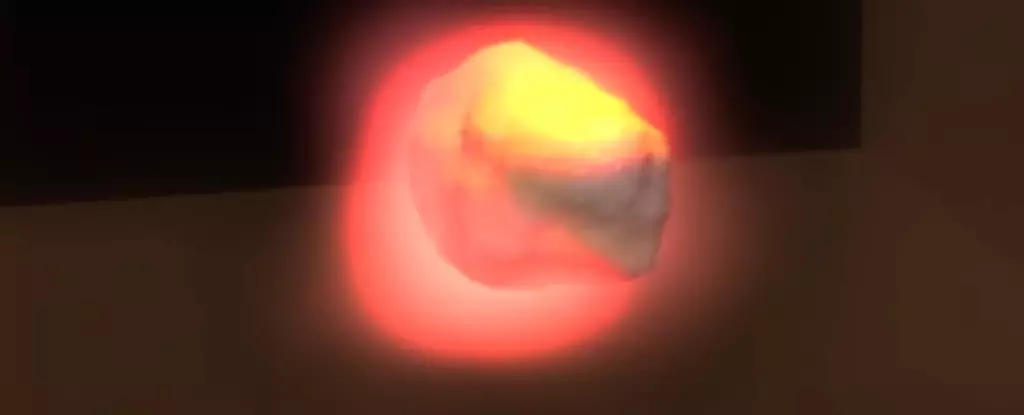The exploration of Mars has taken significant strides, driven by numerous missions aimed at unraveling the mysteries of the red planet. The latest breakthrough comes courtesy of NASA’s Curiosity rover, which has made an astounding discovery: it has uncovered the largest organic molecules ever detected on Mars. This revelation is a potential game-changing moment in humanity’s quest to determine whether life ever existed on this distant world. The importance of these findings transcends mere scientific curiosity; it ventures into existential questions about our place in the universe and the nature of life itself.
These complex, long-chain carbon molecules provide tantalizing hints that Mars may have once harbored conditions suitable for life. On Earth, such molecules play a pivotal role in biological processes. Specifically, they could be remnants of fatty acids, which serve as crucial components in the membranes surrounding living cells. With microbial life—perhaps the most fundamental form of life—being the probable occupant of Mars in its more hospitable past, this discovery could offer vital evidence in the ongoing search for signs of extraterrestrial existence.
The Quest for Molecules of Life
Utilizing the rover’s Sample Analysis at Mars (Sam) instrument, scientists sought to unearth amino acids, the building blocks of proteins, believed essential for life as we understand it. Instead, they stumbled upon incredibly significant organic molecules that reignited excitement within the scientific community. The newly identified hydrocarbons include decane and dodecane, both classified as alkanes, which augment our understanding of Mars’ chemical landscape.
The fact that such molecules were discovered in a 3.7-billion-year-old rock, termed Cumberland, located in what is presumed to be a desiccated lakebed within Gale Crater, lends credence to the notion that this area may have been a cradle for life. The intricate interplay between these organic compounds and the ancient Martian environment raises crucial questions about their origins. Were they produced by biological activity, or did they form through abiotic processes? This uncertainty leaves the scientific community teetering between excitement and skepticism, igniting passionate discussions about the implications of these findings.
Journey Through Time: Understanding Mars’ Past
Located in a geological region called Yellowknife Bay, the Cumberland rock formations bear a striking resemblance to sediment that accumulates at the bottoms of lakes on Earth. This analogy serves to strengthen the argument that Mars might have once had liquid water—a vital ingredient for life as we know it. Curiosity’s scientific objectives involve scrutinizing the remnants of such ancient lakes, targeting sites where life might have flourished during Mars’ more temperate epoch.
The notion that the hydrocarbons found may have once been integral to more complex fatty acids further ignites the imaginations of astrobiologists. On our planet, the formation of fatty acids occurs as a byproduct of biological activity, particularly through mechanisms that delineate cell membranes. The recognition that ancient Martian soils may bear witness to similar compounds prompts a re-evaluation of the Martian narrative; could these organic remnants act as markers of life that thrived billions of years ago?
The Potential for Future Discoveries
Looking ahead, the Mars Sample Return mission—a collaborative effort involving NASA and the European Space Agency—offers tantalizing prospects for more in-depth analysis. The aspiration to retrieve samples housed by the Perseverance rover fuels hopes that advanced laboratories on Earth might unravel the mysteries surrounding these organic molecules. With superior instruments at their disposal, scientists anticipate that they may finally unlock definitive evidence of life, past or present, on our neighboring planet.
Nevertheless, the road to discovery is fraught with challenges. A recent independent review questioned the escalating budget of the Mars Sample Return mission, prompting agencies to reassess their strategies. Currently, two revised options are under consideration to ensure the mission’s success while balancing financial constraints. Such bureaucratic hurdles can be frustrating, especially given the high hopes surrounding the potential for groundbreaking scientific revelations.
A Glimpse into the Future of Astrobiology
The discovery of these organic molecules from the Cumberland sample may merely scratch the surface of what lies beneath Martian soil. Could longer-chain organic molecules be hiding in plain sight, still intact after millennia of exposure to harsh environmental conditions? The prospect invigorates the field of astrobiology, urging scientists to push the boundaries of their investigations.
The underlying message of these discoveries is clear: Mars is still revealing its secrets. As we continue to explore and analyze the Martian landscape, the possibility that we may someday uncover irrefutable evidence of ancient life remains a profound motivation for researchers and dreamers alike. So, while funding and mission logistics may present hurdles, the unwavering quest for knowledge drives us forward, propelling humanity deeper into the cosmos, with each new finding illuminating our understanding of life beyond Earth.

